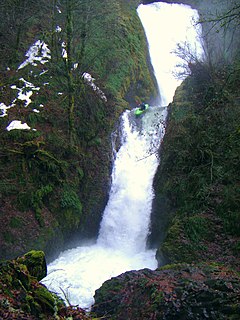
Letchworth State Park is a 14,427-acre (5,838 ha) New York State Park located in Livingston County and Wyoming County in the western part of the State of New York. The park is roughly 17 miles (27 km) long, following the course of the Genesee River as it flows north through a deep gorge and over several large waterfalls. It is located 35 miles (56 km) southwest of Rochester and 60 miles (97 km) southeast of Buffalo, and spans portions of the Livingston County towns of Leicester, Mount Morris and Portage, as well as the Wyoming County towns of Castile and Genesee Falls.
Portageville is a hamlet located in the town of Genesee Falls in Wyoming County, New York, United States. Its name derives from the Native American canoeists who would withdraw their craft from the river to avoid going over three waterfalls in the Genesee River gorge now known as Portage Falls. They had to portage several miles to the site of present-day Mount Morris, where they could embark for the rest of the journey downriver.
Mount Morris is a village in the town of Mount Morris in Livingston County, New York, United States. The village population was 2,986 at the 2010 census, out of 4,465 in the entire town. The village and town are named after Robert Morris.

Multnomah Falls is a waterfall located on Multnomah Creek in the Columbia River Gorge, east of Troutdale, between Corbett and Dodson, Oregon, United States. The waterfall is accessible from the Historic Columbia River Highway and Interstate 84. Spanning two tiers on basalt cliffs, it is the tallest waterfall in the state of Oregon at 620 ft (189 m) in height. The Multnomah Creek Bridge, built in 1914, crosses below the falls, and is listed on the National Register of Historic Places.

The Pigeon River forms part of the Canada–United States border between the state of Minnesota and the province of Ontario, west of Lake Superior. In pre-industrial times the river was a waterway of great importance for transportation and the fur trade.

The Genesee River is a tributary of Lake Ontario flowing northward through the Twin Tiers of Pennsylvania and New York in the United States.
Portage is a town in the southwest corner of Livingston County, New York, United States. The town is at the south end of Letchworth State Park. The name of the town stems from the need to portage (carry) canoes around the falls of the Genesee River. The population of Portage was 884 at the 2010 census.

The Onondaga Limestone is a group of hard limestones and dolomites of Devonian age that form an important geographic feature in some areas in which it outcrops; in others, especially its Southern Ontario portion, the formation can be less prominent as a local surface feature.

Stony Brook State Park is a 568-acre (2.30 km2) state park located in Steuben County, New York. It is located south of Dansville, Livingston County, New York Dansville, Steuben County, New York on New York State Route 36.

Taughannock Falls State Park is a 750-acre (3.0 km2) state park located in the town of Ulysses in Tompkins County, New York in the United States. The park is northwest of Ithaca near Trumansburg.

Oneonta Gorge is a scenic gorge located in the Columbia River Gorge area of the American state of Oregon. The U.S. Forest Service has designated it as a botanical area because of the unique aquatic and woodland plants that grow there. Exposed walls of 25-million-year-old basalt are home to a wide variety of ferns, mosses, hepatics, and lichens, many of which grow only in the Columbia River Gorge. Oneonta Gorge with its 50 species of wildflowers, flowering shrubs and trees has been described as "one of the true dramatic chasms in the state." The Oneonta Gorge Creek Bridge is listed on the National Register of Historic Places.

The Genesee Valley Canal is a former canal that operated in central New York between 1840 and 1878. It ran for a length of 124 miles, passing through 106 locks. Its course was later used by the Genesee Valley Canal Railroad and today comprises portions of the Genesee Valley Greenway.

The Bridal Veil Falls is a waterfall located on Bridal Veil Creek along the Columbia River Gorge in Multnomah County, Oregon, United States. The waterfall is accessible from the historic Columbia River Highway and Interstate 84. Spanning two tiers on basalt cliffs, it is the only waterfall which occurs below the historic Columbia Gorge Scenic Highway. The Bridal Veil Falls Bridge, built in 1914, crosses over the falls, and is listed on the National Register of Historic Places.

New York State Route 436 (NY 436) is an east–west state highway located in the western portion of New York in the United States. It extends for 23.80 miles (38.30 km) from an intersection with NY 39 in the Pike hamlet of Lamont to a junction with NY 36 in the village of Dansville. In between, the route passes through Letchworth State Park near its southern tip and serves the village of Nunda, where it meets NY 408. NY 436 also passes through the hamlet of Portageville, located at the southern end of Letchworth State Park on NY 19A, which NY 436 overlaps north of the community. Most of NY 436 is a two-lane highway that traverses largely rural areas of Wyoming and Livingston counties.

Lehigh Gorge State Park is a 4,548 acres (1,841 ha) Pennsylvania state park in Luzerne and Carbon Counties, Pennsylvania. The park encompasses a gorge, which stretches along the Lehigh River from a U.S. Army Corps of Engineers flood control dam in Luzerne County to Jim Thorpe in Carbon County. The primary recreational activity at Lehigh Gorge State Park is white water rafting.

William Pryor Letchworth was an American businessman notable for his charitable work, including his donation of his 1,000 acre estate to the State of New York which became known as Letchworth State Park.

Many steamboats operated on the Columbia River and its tributaries, in the Pacific Northwest region of North America, from about 1850 to 1981. Major tributaries of the Columbia that formed steamboat routes included the Willamette and Snake rivers. Navigation was impractical between the Snake River and the Canada–US border, due to several rapids, but steamboats also operated along the Wenatchee Reach of the Columbia, in northern Washington, and on the Arrow Lakes of southern British Columbia.

The Glen Iris Inn, William Pryor Letchworth's former home, is located on the top of a cliff overlooking Middle Falls in Letchworth State Park, New York State, USA. William Letchworth found the day-to-day operations of business burdensome and sought refuge on the site, where decided to build a home. He settled on the location while seeing it from a high railroad bridge as a tourist on an Erie Railroad passenger train, gazing at the view in what the Seneca Indians called the Sehgahunda Valley, through which the Genesee River flowed. In 1859, he purchased his first tract of land near Portage Falls.

The Genesee Arch Bridge is a steel arch railroad bridge over the Genesee River in Letchworth State Park, Livingston County, New York. It is the third bridge at this location: the original timber bridge burned in 1875 and was replaced by an iron bridge, which lasted until it was replaced by the current bridge in 2017. It carries the Southern Tier Line of Norfolk Southern Railway.



















